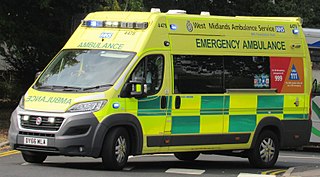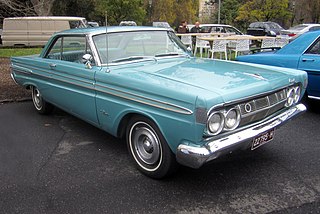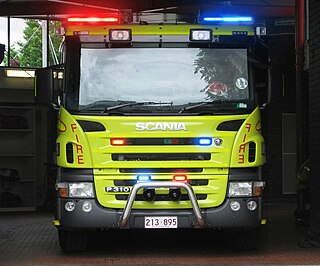
A hearse is a large vehicle, originally a horse carriage but later with the introduction of motor vehicles, a car, used to carry the body of a deceased person in a coffin at a funeral, wake, or memorial service. They range from deliberately anonymous vehicles to heavily decorated vehicles.

An ambulance is a medically equipped vehicle which transports patients to treatment facilities, such as hospitals. Typically, out-of-hospital medical care is provided to the patient during the transport.

The Mercury Comet is an automobile that was produced by Mercury from 1960–1969 and 1971–1977 — variously as either a compact or an intermediate car. In its first two years, it was marketed as the "Comet" and from 1962 as the "Mercury Comet".

Coupé de ville — also known as town car or sedanca de ville — is a car body style produced from 1908 to 1939 with an external or open-topped driver's position and an enclosed compartment for passengers. Although the different terms may have once had specific meanings for certain car manufacturers or countries, the terms are often used interchangeably.

A school bus is any type of bus owned, leased, contracted to, or operated by a school or school district. It is regularly used to transport students to and from school or school-related activities, but not including a charter bus or transit bus. Various configurations of school buses are used worldwide; the most iconic examples are the yellow school buses of the United States which are also found in other parts of the world.
There are many types of car body styles. They vary depending on intended use, market position, location, and the era they were made in.

The first call vehicle is a vehicle used in the funeral service industry. This type of vehicle is used to pick up the remains of a recently deceased person, and transport that person to the funeral home for preparation. This initial pickup is called the "first call", hence the name of these vehicles. While some funeral homes will use their hearse for these initial pickups, having vehicles specifically for first calls and using the hearse solely for funerals reduces wear on hearses and makes the first call process more discreet. Sometimes, when the procession portion of funeral protocol comes into play, First Call vehicles double as funeral yield vehicles, which grants the procession the right of way.

The Cadillac Commercial Chassis is a chassis that was built by the Cadillac division of General Motors. Produced from 1931 to 1979, the Commercial Chassis was constructed as an incomplete vehicle intended for use by coachbuilders for final assembly and fitment of bodywork. Produced on the D platform throughout its entire production, the Commercial Chassis was initially derived from the Series 355, shifting to the Series 75 from 1936 onward.
The Wayne Corporation was an American manufacturer of buses and other vehicles under the "Wayne" marque. The corporate headquarters were in Richmond, Indiana, in Wayne County, Indiana. During the middle 20th century, Wayne served as a leading producer of school buses in North America.

A police car is a ground vehicle used by police and law enforcement for transportation during patrols and responses to calls for service. A type of emergency vehicle, police cars are used by police officers to patrol a beat, quickly reach incident scenes, and transport and temporarily detain suspects, all while establishing a police presence and providing visible crime deterrence.

The Ectomobile is a fictional vehicle from the Ghostbusters franchise. It appears in the films Ghostbusters (1984), Ghostbusters II (1989), the reboot, where in it appears as a hearse as opposed to the original's ambulance, Ghostbusters (2016), Ghostbusters: Afterlife (2021), in the animated television series: The Real Ghostbusters, Slimer! and Extreme Ghostbusters, and in the video games Ghostbusters: The Video Game and Beeline's Ghostbusters iOS app.
Superior Coach was a coachbuilder in the American automotive industry. Founded in 1909 as the Garford Motor Truck Company, Superior is best known for constructing bodies for professional cars (hearses) and school buses. Following major downturns in both segments in the late 1970s, Superior was liquidated by its parent company in 1980. From 1925 to 1980, the company was based in Lima, Ohio.
A professional car is loosely defined as a vehicle based on a special long wheelbase commercial chassis and sometimes, though rarely, on modified passenger car chassis, for use as a hearse, flower car, service car, ambulance, limousines or for a combination of purposes. The term is mostly used in the United States.

Emergency vehicle lighting, also known as simply emergency lighting or emergency lights, is a type of vehicle lighting used to visually announce a vehicle's presence to other road users. A sub-type of emergency vehicle equipment, emergency vehicle lighting is generally used by emergency vehicles and other authorized vehicles in a variety of colors.

Emergency vehicle equipment is any equipment fitted to, or carried by, an emergency vehicle, other than the equipment that a standard non-emergency vehicle is fitted with.

The Cadillac V8, introduced as the Type 51, is a large, luxurious automobile that was introduced in September 1914 by Cadillac as a 1915 model. It was Cadillac's first V8 automobile, replacing the four-cylinder Model 30, and used the all new GM A platform for the entire series shared with all GM division brands using a 122 in (3,099 mm) wheelbase, while a 145 in (3,683 mm) chassis was offered separately to be used for custom coachwork. The Types 53, 55, 57, 59, and 61 were introduced every year through 1923 with yearly improvements until an all new platform was substantially updated and introduced as the V-63 using the business philosophy called planned obsolescence. It was built at the Cass Street and Amsterdam Avenue factory in Detroit, with the coachwork provided by Fisher Body. The chassis could be purchased separately and sent to the clients choice of coachbuilder optionally.

Courtesy lights are used to request right-of-way primarily by volunteer or on-call firefighters and emergency medical technicians (EMTs) to expedite their drive in their privately owned vehicles, to their firehouse or base. Courtesy lights sometimes allow the user to disobey traffic laws such as speed limits, but usually not laws applying to stop signs or stop lights. Courtesy lights should not be confused with emergency warning lights used in conjunction with audible warning systems (sirens) for emergency vehicles such as police cars, fire apparatus, and ambulances, nor should they be confused with warning lights as used by tow trucks, snow plows, construction vehicles and school buses to increase awareness especially when moving slowly or stopped in the roadway.

The history of the ambulance begins in ancient times, with the use of carts to transport patients. Ambulances were first used for emergency transport in 1487 by the Spanish forces during the siege of Málaga by the Catholic monarchs against the Emirate of Granada, and civilian variants were put into operation in the 1830s. Advances in technology throughout the 19th and 20th centuries led to the modern self-powered ambulances.

The Cadillac Series 355 was a V8-powered luxury car manufactured by Cadillac from 1931 until 1935. It was offered as a 2-door club coupe, 2-door convertible, 4-door convertible, 4-door sedan, 4-door town car, and 4-door limousine. It provided a range of Cadillac below the maker's larger V-12 and V-16 lines. It was succeeded by the Cadillac Series 70/75.
The New York City Fire Department Bureau of Emergency Medical Services is a division of the New York City Fire Department (FDNY) in charge of emergency medical services for New York City. It was established on March 17, 1996, following the merger of the FDNY and New York City Health and Hospitals Corporation's emergency medical services division. FDNY EMS provides coverage of all five boroughs of New York City with ambulances and a variety of specialized response vehicles.
















